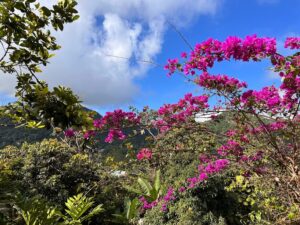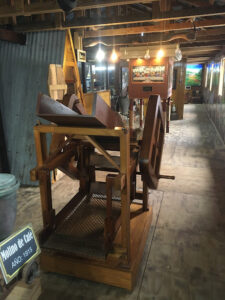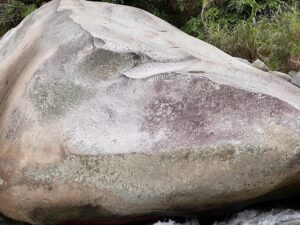As we had just finished a satisfyingly jam-packed day in San Juan, falling in love with the city many times over, we decided to spend our time for our sixth day taking it easy in the secluded Puerto Rican mountains. After all, that’s how we initially envisioned this little trip: a quiet time away, tucked quietly in more remote parts of the island, lounging by the pool, preparing meals on the grill, and drifting away into a world free of everyday worries. And so, a satisfyingly slow day it was.

Nuestra casita en las montañas had more than just incredible views of the Puerto Rican mountains and a refreshingly cool pool, it also had a lovely little gazebo just a few feet down the mountainside. So we started our day relaxingly by brewing and enjoying the tasty coffee that all the panaderías here have. We also had been marveling at some fruit trees that were growing just outside our side of the fence: something that looked like oranges and another that looked like papayas but more acorn-shaped. I tried identifying the later fruit in various searches but haven’t been able to come to a satisfactory conclusion, so if anyone knows what the fruit is, please let me know. (We will eventually open the fruit up on our twelfth and final day in Puerto Rico, so stay tuned for more information.)
We naughtily couldn’t resist trying to get a taste of the forbidden fruits, as it were (at least I couldn’t resist, Amy suggesting we should leave well enough alone), so I grabbed the net normally meant for cleaning the pool, extended it across the fence, and yanked one of the “oranges” and one of the “papayas” off the trees hopefully with no one noticing (not that we were surrounded by many people).

The “orange” seemed ripe enough so we threw it into a salad with una piña and an actual papaya we had purchased earlier and then left the other so-called “papaya” we just picked to ripen. If the orange was an orange, it tasted more like grapefruit, but the sweetness of the pineapple helped to offset the bitterness. We also decided to have some mimosas with our fruit salad but with a Puerto Rican flare: instead of cava or champagne we improved the recipe with ron (that’s rum, of course).
Amy and I were ready for a swim, as we usually were every morning—rum mimosas in tow, sitting safely at the pool’s edge for sips in between watery strokes—while Aaron opted to only submerge his feet (“I’m a big comfort guy,” he’d say, the water far too cool for his comfort). Following our swim, we prepared some rice, eggs, and toast, and as we were eating outside taking in the glorious mountain air, an alarmingly large, black insect flew past our table and landed on a purple flower on a nearby tree a few feet away.
Thus far, the insect life had been remarkably invisible, even though we had prepared ourselves to encounter countless mosquitos, giant tranchulas, and pesky flies. But this large flower-loving insect was the closest encounter we had so far with any neighbors who happened to be disquieting critters. We surmised it was a bee, so we used this field guide to help identify it. And it was, indeed, the xylocopa mordax—a carpenter bee—and while its appearance was alarming, it is generally docile unless you treat it unfavorably.

The afternoon was by this point well underway, so we decided to make our way to a nearby coffee plantation museum that we had driven past a few times, Hijos del Cafetal or Children of the Plantation. All the exhibits are entirely in Spanish, so unless you studied up a bit, you won’t be able to enjoy the history of coffee in Puerto Rico very well (indeed, I probably understood only about 10% of it), but you’ll at least be able to appreciate the various artifacts and artworks on display. I had remarked earlier to the docent who was on hand, “Hablamos un poco español, pero no muy bien,” and she laughed, and later I remarked, “Leer es más facíl.” But she was so helpful as she explained things in flawless English whenever we asked questions.
One particular placard caught our eyes, however: an image depicting imports arriving into Puerto Rico but no exports leaving it, with the caption: “El Gobierno americano permite la entrada de café de otros países. Se perdió el mercado Europeo,” which is, “The American government permitted coffee imports [to Puerto Rico] from other countries, but the European market was lost.”
We found this deeply alarming, so we asked the docent more information about this particular fact. She explained that the U.S. government does not allow Puerto Rico to export its coffee and other goods to other countries, only to the U.S. itself. After my own additional research, this was perhaps a bit of a misleading simplification of the facts. Regardless, a serious problem still exists; it’s just a little complicated to explain.

There is an old law on the books, the Jones Act from 1920, which states that any sea vessel can enter Puerto Rico, but any ship that travels between two U.S. ports must be built in the U.S. and staffed primarily by people from the U.S. It’s purely a protectionist law created following World War I. The law, in turn, drives up shipping costs, not only between any two U.S. states but especially to island ports in Hawaii and Puerto Rico. This law—along with a desire by the U.S. at the turn of the 20th century to prioritize sugar over coffee—seems to have severely and negatively impacted the coffee market between Puerto Rico and Europe.
I’m not going to pretend that I fully understand this—and I also fear that I’m not explaining any of this very well—so I encourage you to do your own reading about this problem and compare what I’ve found to what you can find. I think we can all agree, however, that the question of Puerto Rico’s territorial status, statehood, or independence is extremely complicated and fraught with problems of all sorts, that it’ll take people smarter than I am to figure out what the best solution would be. Unfortunately, since Puerto Rico doesn’t have representation in Congress and can’t vote for president, enacting any meaningful change requires an uphill battle.
Following the museum—but not before we enjoyed some delicious coffee at the museum’s outdoor cafe—we made our way into the town of Jayuya to view some ancient Taíno petroglyphs, Piedra Escrita del Rio Saliente. Taíno petroglyphs are found throughout the island, and I encourage you to seek them out to appreciate the elegantly swirling shapes by artists from long, long ago. The petroglyphs at Piedra Escrita are especially satisfying to view as they are inscribed into a giant, giant boulder that sits in the gently flowing waters of the Rio Saliente, a sturdy wooden walkway leading visitors from the roadside down to the riverfront.
Time flies, it seems, even when moving more slowly, as our afternoon was already over. (We wanted a more relaxed day after all.) So before we returned home, we stopped by an ever reliable Econo—now our favorite supermercado chain here—to pick up some groceries to make our dinner. We wanted to try to make our own mofongos rellenos, but we didn’t quite have the tools necessary to smash the cooked plantains to shape into the bowl-shaped delight. So we instead enjoyed plantains cooked lightly in oil; beans with sofrito, onions, peppers, and potatoes; and chicken marinated in more sofrito and grilled. It was a great way to conclude a satisfyingly slow day.
Our following day would prove to be equally relaxing as we headed north to enjoy Puerto Rico’s incredible beaches…
Spanish lesson for the day:
- Spanish for coffee is café, while milk is leche and sugar is azúcar.
- Con means with and sin means without.
- See where this is going? “Quiero un café con leche y sin azúcar, por favor.” Now—using lessons from previous posts—go ahead and figure out how to say, “We want two coffees with sugar and without milk, please.”
- Spanish for tea is té but don’t ever order that in Puerto Rico. It’s gross. Just stick with café.
Travel tips, day six:
- On Sundays in the more remote parts of the island, things will generally close at 5 or 6 in the evening. The Econo in Jayuya, for example, closed right at 5 (despite Google saying it would close at 6), so if you need something and it’s Sunday, make sure to plan ahead.
- We had brought so much deet to protect us from all the mosquitos, but we never used it once, despite other travel sites telling us to prepare for the worst.
- You’ll be able to find sofrito growing on trees here. Well, not really. But you’ll definitely be able to find it aplenty in any supermercado or panadería.
*These photos by Amy Danielson. All others by me.

0 comments on ““Se perdió el mercado europeo” – unas vacaciones en Puerto Rico, día seis”
1 Pings/Trackbacks for "“Se perdió el mercado europeo” – unas vacaciones en Puerto Rico, día seis"
[…] the locals’ perspectives on Puerto Rican statehood. I had written about this a little bit on día seis when we visited the coffee plantation museum in Jayuya, and our conversation with the bartender did […]